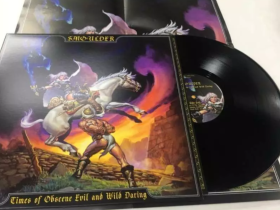(TheBRHM.com) Rockabilly is both a genre that is easy to explain and—like other musical genres—requires a layered explanation. All of this stuff has a history to it, after all. As for rockabilly, the easiest way to explain it is that it’s a very early form of rock music. As a matter of fact, it would be safe to say it’s pre-rock n roll or a contemporary of rock n roll.
Look at it as two species that existed around the same time only for one to thrive and flourish while the other doesn’t exactly become extinct but it doesn’t have a large population. Oh, but it’s still around and has morphed into different forms. However, let’s get back to rockabilly proper.

What Exactly is Rockabilly
Formed in the early 1950s, rockabilly takes its roots from country music and old-school rhythm and blues—different from what is better known as RnB today. It’s that really old form of rock music that has a country boogie to it. Actually, boogie-woogie music contributed heavily to rockabilly and rock n roll. While you can hear the influence in early rock n roll, it’s very prominent in rockabilly.
To a musically untrained ear like my own, rockabilly is the livelier 1950s rock n roll. It’s like sock-hop rock. There’s an element of it where you can see why it was popular with post-World War II teens. It was different from what their parents listened to and still had that degree of blues’ rebelliousness to it. Even easier is to say that rockabilly is rock n roll with more “twang” to it.
It’s the strain of rock n roll played by Jerry Lee Lewis and a young Elvis Presley.
That’s a vague description and again—I don’t have musically-trained ears—the subtleties of two closely related subgenres of rock music such as rockabilly and rock n roll is all in the overall sound and not particulars like pitch, tone, and tempo. With that said, there’s a twang that rockabilly has that rock n roll lacks.
It could be because of that twang—which keeps it rooted to country music—that rockabilly didn’t make it out of the 1950s popularity-wise. Again, rockabilly didn’t just die out. A genre doesn’t die unless there are just no more artists to perform or produce works in that vein. Bands and artists didn’t just pull up stakes when rock n roll surpassed rockabilly and grew into other genres.
However, it was on life support for a couple of decades until a renewed interest in the rockabilly sound in the 1970s with punk and goth-influenced acts making new genres such as psychobilly and gothabilly. In that same period of time, rock n roll gave birth to Southern rock, heavy metal, punk rock, and other subgenres that would go on and create others.
Stage Performance
Honestly, there’s quite a bit of rockabilly live performances available online. You’ll see more from modern or long-time acts than from the pioneering acts. I feel that when going into the history of a genre or introducing it, you need to check out performances from its formative years. It’s like going into heavy metal and not mentioning the Soundhouse performances or hip-hop and skipping over “Rapper’s Delight”.
The most notable performances you’ll see is of Elvis’ version of “Blue Suede Shoes” or “Jailhouse Rock” or Jerry Lee Lewis’ “Great Balls of Fire”. Wouldn’t you know it: both songs are also counted as influential rock n roll tunes. These songs a long with “Rock Around the Clock” are good introductions to the popular side of rockabilly before really diving into the genre.
The live and televised performances of those tracks give you a good idea of the energy and tempo of rockabilly but as is the case with any genre, they’re not the collective best example. They’re great examples—and at least one or two would be considered the best example. However, they achieved a level of mainstream popularity during the genre’s peak that kept them in listeners’ ears for decades after.
I’d summon up some of the ones I’ve viewed as high-energy with lead singers who really need to bring the charisma. It’s not merely singing or playing, they were performing and the young crowds often matched that energy. It was a genre that was at home with and often gave a contrast to 1950s soul and doo-wop while keeping tempo with genres like jazz and surf rock.
Now, I’m no music historian but I’d say that rockabilly contributed not only to the sound of rock music in general but also stagecraft as far as the live and broadcast element.
We’re introducing rockabilly as we’ll get into so of the landmark songs and albums as well as what came out of it—just like with other genres that influenced and were influenced by rock music. Yes, that means we’re getting to psychobilly—my personal favorite rockabilly derivative—so recommend some acts and also recommend some rockabilly acts you feel might be lost to history.
Staff Writer; M. Swift
This talented writer is also a podcast host, and comic book fan who loves all things old school. One may also find him on Twitter at; metalswift.










Leave a Reply